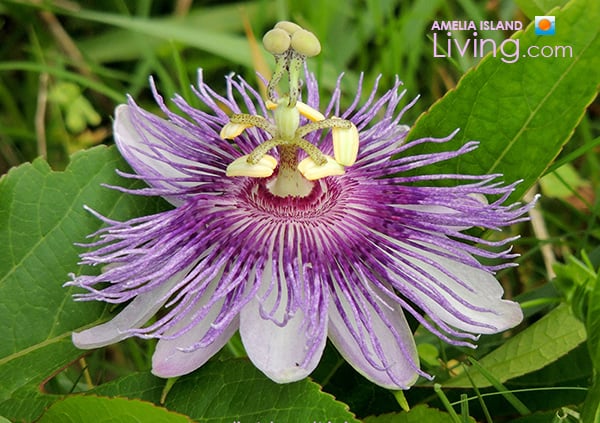In the coastal South, summertime blooms dot the seascape adding pops of color in natural areas. Take a look at nature’s beauty, a selection of Amelia Island wildflowers seen in the dunes at the seashore and in the marsh habitat of Egans Greenway.
Scarlet Spikes in the Dunes

Swaying in seaside breezes along with the sea oats, pictured above, a spray of scarlet in the dunes on Amelia Island. Standing Cypress, beautiful bright red spikes of tubular flowers, have fern-like leaves on tall stems that can reach 3 to 6 feet.

Adding a lovely splash of color at the oceanfront (pictured here in the Summer Beach area), these wildflowers, also known as “Spanish Larkspur,” have also been spotted recently in the sand dunes at Amelia Island State Park. (Scientific name, Ipomopsis ruba).
Indian Summer

Wildflowers, Barrier Island Blooms
Seen above, wild Blanket Flower blooming near 60-foot dune system (the state of Florida’s tallest dune dubbed “NaNa”), on Amelia Island at American Beach.

Blanket Flower is also known as “Indian Blanket” and “Firewheel.” A highly salt-tolerant plant, it thrives in full sunshine and dry, sandy areas — dunes and coastal scrub. (Scientific name, Gaillardia pulchella.)
Cheerful Seaside Yellow

Seen around Amelia Island’s dunes, from one end of the island to the other, these yellow native wildflowers border the beach.

Beach Sunflower features “10-20 yellow rays” around a brown center disk. A spreading perennial, Beach Sunflower is an ideal flowering ground cover for coastal landscapes. It thrives in sandy soil, can take full sun and salt spray. (Scientific name Helianthus debilis.)

Attracting bees and butterflies and prolific in the coastal dunes, yellow flowering Partridge Pea also produces seed pods that songbirds like to eat. Partridge pea is also a forage plant of the gopher tortoise (they live in burrows in the dunes and can often be spotted roaming around). Photographed above at historic American Beach on Amelia Island. (Scientific name Chamaecrista fasciculata.)
Coastal White

Beach Morning Glory, a white wildflower with yellow throat (AKA “fiddle-leaf”), seen here at Peters Point Park. The blooms open in the a.m. and close in afternoon heat. (Scientific name Ipomoea imperati (Vahl) Griseb.)

The long, green trails of another morning glory, Railroad Vine (AKA bayhops), adds pops of purple against the white sand, pictured here at Amelia Island State Park. Railroad vine is a dune stabilizer, the blooms also open in morning and close in the afternoon. (Scientific name Ipomea pes-caprae.)
Purple Passion

Those who take a nature walk in the Greenway’s salt marsh habitat (photos from north side), will be rewarded with an outstanding display of purple Passionflowers. A rather intricate flower with a delicate fringe, it’s one of the most interesting and lovely native wildflowers seen blooming summers along the trails adjacent to Egans Creek. (Scientific name Passiflora incarnata.)
Pretty In Pink

Three’s a charm, this pale pink, dainty-looking wildflower. Native to Florida (and Alabama), Large-flower Rosegentian has an intricate center, a 5-pointed yellow star with red outline. This pretty bloom is also known as “marsh pink.” Rosegentian likes moist sites and marsh edges, pictured here growing in Egans Greenway (north), but also seen this summer at Fort Clinch State Park. (Scientific name Sabatia grandiflora.)

Seashore mallow, also known as Virginia saltmarsh mallow, is abundant in the Greenway. These pink blooms can be spotted along water’s edge (often seen growing alongside Southern cattails). (Scientific name Kosteletzkya pentacarpos L.)
Florida-Friendly Landscaping
Many people these days are re-thinking yard sod. Florida property owners can use a selection of these native Florida wildflowers, plus many more, for a beautiful and environmentally-friendly Southern coastal garden. Learn tips to achieve a thriving landscape of wildflowers and native plants and trees (that may also save you time and money), by visiting University of Florida’s “Florida-Friendly” Landscaping website (Extension, Institute of Food and Agricultural Sciences — IFAS). Mimic what Mother Nature put here in the first place, for Florida gardening success.
What’s Blooming Throughout Florida?
Want to know what’s blooming around the Sunshine State? Check out the Florida Wildflower Foundation’s wildflower map by county. Also find out more about buying wildflower seeds.
Learn more about Florida State Statue 581.185 to preserve and protect native Florida flora. It’s best to “click not pick!”


